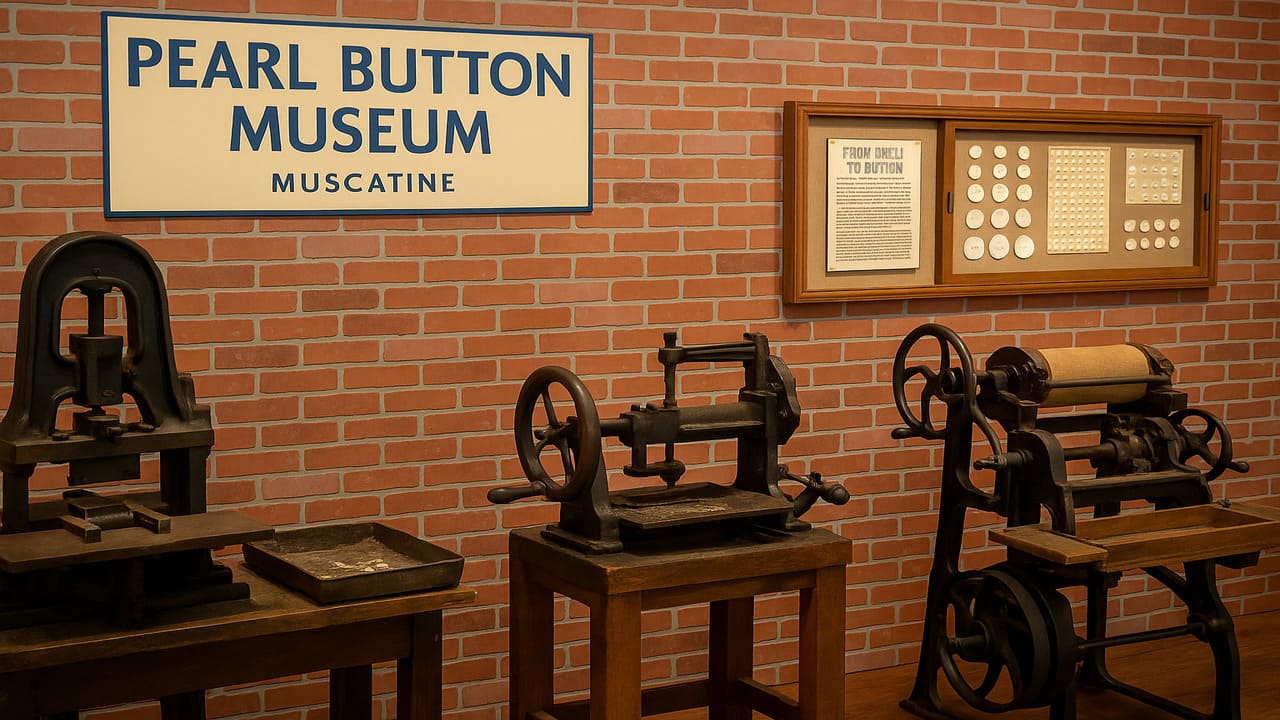
Meet Muscatine – Pearl Button Museum, part of the National Pearl Button Museum at the History and Industry Center, offers a fascinating glimpse into a unique chapter of American industrial history. Known as the “Pearl Button Capital of the World”, Muscatine earned this title in the late 19th and early 20th centuries, when it became the epicenter of button manufacturing using freshwater mussel shells from the Mississippi River and its tributaries.
The museum vividly tells the story of how a small Midwestern city rose to national prominence through a highly specialized craft. During its peak, Muscatine produced over 1.5 billion pearl buttons annually, supplying nearly 40% of the world’s buttons. This industry not only defined the city’s economy for decades but also shaped its culture, labor force, and identity. Walking through the Pearl Button Museum, visitors can trace this legacy from its river-based raw material gathering to the mechanical evolution of button-making technology.
What makes the Pearl Button Museum exceptional is its commitment to authenticity and detail. The collection houses original button-cutting machines, intricate presses, and finishing tools once used by factory workers. These machines, many of which are still functional, demonstrate how river mussel shells were transformed into polished, iridescent buttons. The clatter and hum of machinery that once filled the town’s button factories are brought to life in multimedia exhibits that blend history with sensory experience.
The museum also features historical photographs, worker uniforms, and even personal journals from button factory employees. These items give voice to the thousands of men, women, and even children who worked in the industry some in large factories, others from their homes in cottage-based production systems.
Additionally, interactive touchscreens allow visitors to explore the broader social context of the pearl button boom. Topics such as immigration, child labor laws, and industrial innovation are woven into the narrative, showing how Muscatine’s local story fits into the national fabric of American manufacturing.
Read More : Luxury and Romance Await in Monaco: The Top Destination
Beyond preservation, the Pearl Button Museum functions as a hub for local engagement and learning. School groups regularly visit the center, where they participate in hands-on workshops like shell-cutting demonstrations and button-making activities. These programs aim to connect younger generations with the city’s unique history in a tangible, memorable way.
The museum also collaborates with local historians, artisans, and universities to host rotating exhibitions and public lectures. Topics often expand beyond buttons, exploring broader themes like river trade, industrialization in the Midwest, and even fashion history, providing a deeper appreciation for how this niche industry influenced the world.
In recent years, the museum has expanded its programming to include digital outreach, virtual tours, and online archives. This ensures that even those who cannot visit in person can still access and appreciate Muscatine’s extraordinary contribution to the garment and manufacturing industries of the past.
While the Pearl Button Museum is a historical landmark in its own right, it also plays a vital role in Muscatine’s growing reputation as a cultural and tourism destination. Located conveniently along Muscatine’s scenic riverfront, the museum is just a short walk from Riverfront Park, the Mississippi Riverwalk, and downtown shops and restaurants. This proximity allows tourists to immerse themselves not just in history, but also in the vibrant local atmosphere.
The museum frequently partners with other cultural institutions in Muscatine, such as the Muscatine Art Center and local historical societies, to create citywide events and walking tours. These collaborative efforts have helped position the town as a small but meaningful stop along the Great River Road, a scenic byway that traces the length of the Mississippi River.
Muscatine’s investment in its historic downtown and riverfront infrastructure has made it easier than ever for tourists to explore the Pearl Button legacy while enjoying modern amenities. Whether you’re a history buff, a student of industrial design, or simply curious about small-town ingenuity, the Pearl Button Museum offers a compelling reason to visit Muscatine and perhaps, to stay a little longer.
Read More : Exploring the Running River Trail System: Muscatine’s Scenic Outdoor Escape